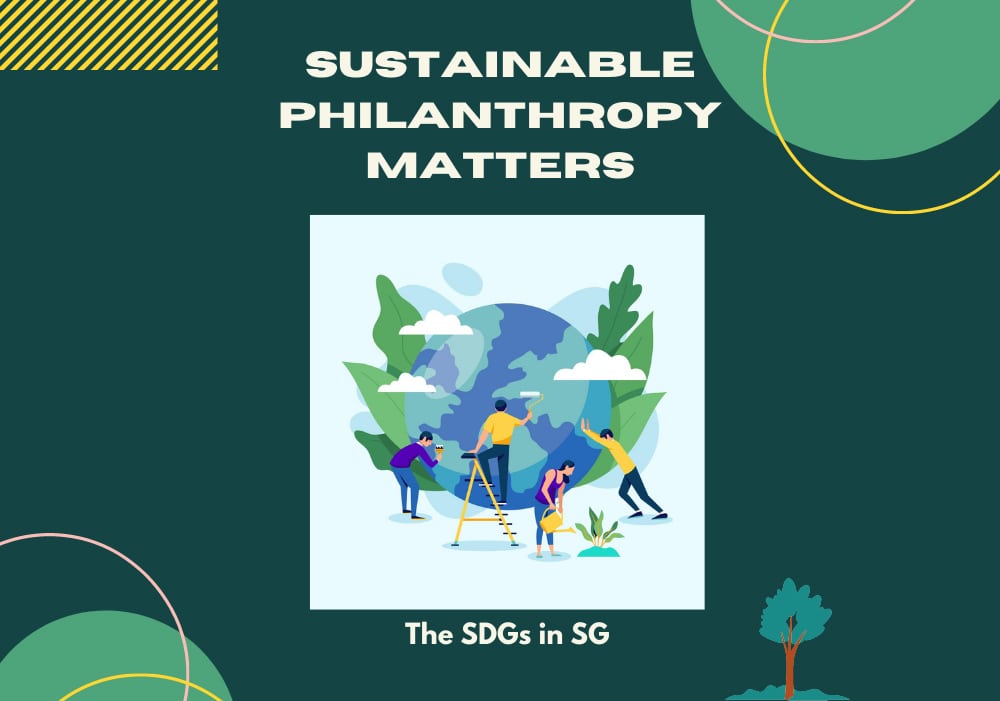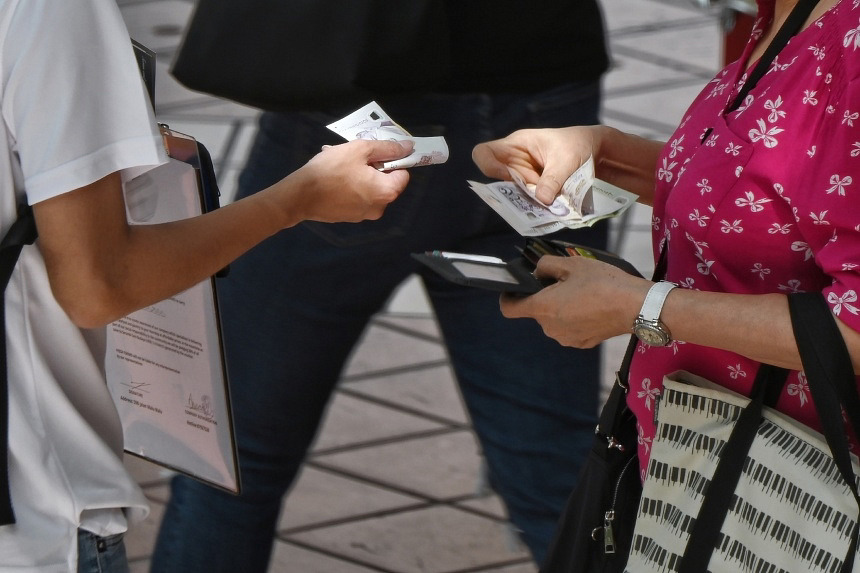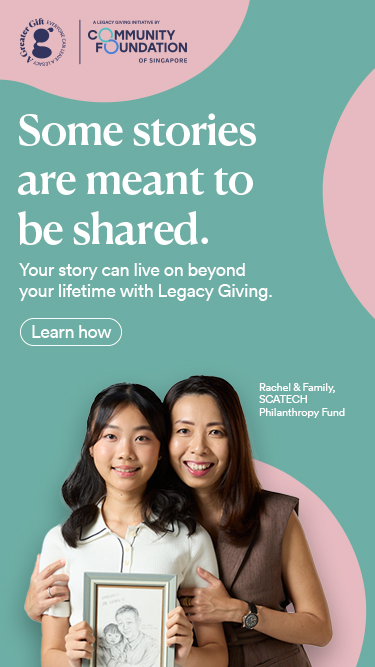Sustainable Philanthropy Matters: The SDGs in SG


In this three-part series ‘Sustainable Philanthropy Matters’, we explore the surprisingly intimate relationship between philanthropy and sustainability and how the practice of one can in fact, lead to the advancement of the other. Both of these issues are close to our hearts here at CFS and we want to share how our philanthropy can help preserve our planet, our communities and our future.
In our previous article, we took a brief look at the history of philanthropy and sustainability. Here, we will examine the relatively newer Sustainable Development Goals (SDGs) and their paramount relevance and importance today. The SDGs were adopted as a universal call to action to end poverty, protect the planet and ensure that all people enjoy peace and prosperity. Additionally, the SDGs could and should serve as a guide to the next steps in Singapore’s social, environmental and even philanthropic evolution. Donors can create a greater impact with their giving by ensuring alignment with the SDGs.
Introducing the SDGs
When it comes to the 3P’s, People has long been seen as the more important P as compared to Planet (let us not talk about Profit!).
Of the eight Millennium Development Goals established in 2000 by the UN, only one was environment-related. Even in the first-ever Global Philanthropy Report, published relatively recently in 2018 by the Hauser Institute for Civil Society (Johnson, 2018), education was the most popular cause of choice for foundations around the world, with 35% focusing on at least one aspect. Health and social welfare also featured largely as priorities. Only one region, Latin America, had environment and animals as a focus and even then, at only 23.8%.
The 17 SDGs, birthed in 2015 at COP 21 in Paris, catapulted the idea of sustainability into everyone’s consciousness in vivid colour. It illustrated that sustainability encompasses many facets of society as well as the natural environment, with an infinitely long-term view of providing for future generations.At first glance, many of the SDGs seem to talk about social aspects anyway, but the beauty of the SDGs is that each goal is inextricably linked to several others. For instance, an initiative ensuring that farmers get paid decent wages while tapping on technology to grow food that is organic and pesticide-free aligns to SDGs 1, 2, 3, 8, 9 and 12.
SDGs in Singapore
Delving deeper into the 169 targets of the SDGs, one realises that quite a few of them may not seem to apply to Singapore. As a highly developed and modern country with a high GDP, 100% literacy rate and no real primary industries like mining, forestry and agriculture, we can claim to have already met many of the SDGs’ targets.However, it is the spirit of the SDGs at which we should look, and it is then that we realise that there is definitely more that we could do.
Let us examine SDG 1, No Poverty. Singapore claims that the first two indicators do not apply as we have no poverty line, national or international (Department of Statistics Singapore, 2021). Yet, it is clear that cases of relative poverty still exist in Singapore (Ng, 2018). The problem can be simply explained by the high cost of living in Singapore (ECA International, 2021), our high Gini coefficient (World Population Review 2021) and the majority of the households having an income below the national average (Dayani, 2021) but the fact remains that the problem exists, and we need to address it within the Singaporean context.
Thankfully, besides the Government’s efforts to reduce social inequality (Lai, 2019), Singapore has had a long history of philanthropists (Ooi, 2019) who have seen to the needs of their country’s people through their generosity. Fast forward to today, and even the man on the street can be a philanthropist, with easy, direct access to many charity channels and donation portals online.
Everyone Has a Role
Ultimately, this democratisation of philanthropy is a good thing. Accomplishing the vision of “peace and prosperity for people and the planet, now and into the future”, requires the concerted achievement of each and every SDG.
Given the intricate interconnectivity of the SDGs, tackling any project that aims to deal with them would be a daunting task if attempted alone. Just as social issues are complex problems requiring multifaceted approaches by multiple stakeholders, so it is with the SDGs.
The 17th SDG, Partnership for the Goals, actually posits that we all have a role to play. Governments and agencies can only do so much. It is recognised that corporations and individuals alike all have responsibilities towards achieving the environmental growth and strengthening of Singapore (and the planet too, come to think of it). As the late philosopher McLuhan said: “There are no passengers on spaceship Earth. We are all crew.”
Eyes on the Prize
In the previous article of this series, we shared that everyone, whether individual, group or organisation, had reasons to give. It is important to avoid whitewashing or greenwashing (basically, paying only lip service about being philanthropic). Giving back to the community and/or the environment should not be about meeting reporting requirements or ingratiating oneself with the local people.
It can, admittedly, be tricky juggling one’s desire to do a particular act of charity with what said charity might actually want to achieve, or even what the eventual care recipients might really require. With over a decade championing philanthropy in Singapore, CFS deeply understands this need for balance between the desires and objectives of the donors, charities and care recipients. Yes, even if those care recipients are the flora and fauna around us. Visit here to find out how you can add value for People and Planet, today and tomorrow.
To learn more about CFS’s Corporate Sustainability efforts, please read more here.
To read the other 2 stories in the ‘Sustainable Philanthropy Matters’ series, please click below:
This article was written by Adam, a Principal Consultant with CFS and an experienced sustainability practitioner. He is an advocate for sustainable practices. His colleagues are still wondering how his monthly household utilities bill is only around $70.
Disclaimer: The opinions expressed in this publication are those of the author. They do not purport to reflect the opinions or views of CFS or its members.
References
- Department of Statistics Singapore. 2021. Government of Singapore. Singapore. https://www.singstat.gov.sg/find-data/sdg/goal-1
- Ng, Cindy. 2018. Commentary: So this is what the face of poverty looks like. Channel News Asia. https://www.channelnewsasia.com/commentary/this-is-what-the-face-of-poverty-inequality-looks-like-804881
- ECA International. 2021. Singapore drops in global Cost of Living rankings, but remains among top 10 most expensive locations. https://www.eca-international.com/news/june-2021/singapore-drops-in-global-cost-of-living-rankings
- World Population Review. 2021. Gini Coefficient by Country. https://worldpopulationreview.com/country-rankings/gini-coefficient-by-country
- Dayani, Dinesh. 2021. What is Singapore’s Average Household Income And Why It Is Different From The Salaries We Earn? Dollars and Sense. https://dollarsandsense.sg/singapores-average-household-income-different-salaries-earn/
- Lai, Lynnette. 2019. Parliament: Inequality has many causes and needs to be tackled practically, not ideologically, says Desmond Lee. The Straits Times. https://www.straitstimes.com/politics/parliament-inequality-has-many-causes-and-needs-to-be-tackled-practically-not-ideologically
- Ooi, Yu-lin. 2019. Singapore’s Earliest Philanthropists 1819-1867. Asia Centre for Social Entrepreneurship & Philanthropy.
In this three-part series ‘Sustainable Philanthropy Matters’, we explore the surprisingly intimate relationship between philanthropy and sustainability and how the practice of one can in fact, lead to the advancement of the other. Both of these issues are close to our hearts here at CFS and we want to share how our philanthropy can help preserve our planet, our communities and our future.
In our previous article, we took a brief look at the history of philanthropy and sustainability. Here, we will examine the relatively newer Sustainable Development Goals (SDGs) and their paramount relevance and importance today. The SDGs were adopted as a universal call to action to end poverty, protect the planet and ensure that all people enjoy peace and prosperity. Additionally, the SDGs could and should serve as a guide to the next steps in Singapore’s social, environmental and even philanthropic evolution. Donors can create a greater impact with their giving by ensuring alignment with the SDGs.
Introducing the SDGs
When it comes to the 3P’s, People has long been seen as the more important P as compared to Planet (let us not talk about Profit!).
Of the eight Millennium Development Goals established in 2000 by the UN, only one was environment-related. Even in the first-ever Global Philanthropy Report, published relatively recently in 2018 by the Hauser Institute for Civil Society (Johnson, 2018), education was the most popular cause of choice for foundations around the world, with 35% focusing on at least one aspect. Health and social welfare also featured largely as priorities. Only one region, Latin America, had environment and animals as a focus and even then, at only 23.8%.
The 17 SDGs, birthed in 2015 at COP 21 in Paris, catapulted the idea of sustainability into everyone’s consciousness in vivid colour. It illustrated that sustainability encompasses many facets of society as well as the natural environment, with an infinitely long-term view of providing for future generations.At first glance, many of the SDGs seem to talk about social aspects anyway, but the beauty of the SDGs is that each goal is inextricably linked to several others. For instance, an initiative ensuring that farmers get paid decent wages while tapping on technology to grow food that is organic and pesticide-free aligns to SDGs 1, 2, 3, 8, 9 and 12.
SDGs in Singapore
Delving deeper into the 169 targets of the SDGs, one realises that quite a few of them may not seem to apply to Singapore. As a highly developed and modern country with a high GDP, 100% literacy rate and no real primary industries like mining, forestry and agriculture, we can claim to have already met many of the SDGs’ targets.However, it is the spirit of the SDGs at which we should look, and it is then that we realise that there is definitely more that we could do.
Let us examine SDG 1, No Poverty. Singapore claims that the first two indicators do not apply as we have no poverty line, national or international (Department of Statistics Singapore, 2021). Yet, it is clear that cases of relative poverty still exist in Singapore (Ng, 2018). The problem can be simply explained by the high cost of living in Singapore (ECA International, 2021), our high Gini coefficient (World Population Review 2021) and the majority of the households having an income below the national average (Dayani, 2021) but the fact remains that the problem exists, and we need to address it within the Singaporean context.
Thankfully, besides the Government’s efforts to reduce social inequality (Lai, 2019), Singapore has had a long history of philanthropists (Ooi, 2019) who have seen to the needs of their country’s people through their generosity. Fast forward to today, and even the man on the street can be a philanthropist, with easy, direct access to many charity channels and donation portals online.
Everyone Has a Role
Ultimately, this democratisation of philanthropy is a good thing. Accomplishing the vision of “peace and prosperity for people and the planet, now and into the future”, requires the concerted achievement of each and every SDG.
Given the intricate interconnectivity of the SDGs, tackling any project that aims to deal with them would be a daunting task if attempted alone. Just as social issues are complex problems requiring multifaceted approaches by multiple stakeholders, so it is with the SDGs.
The 17th SDG, Partnership for the Goals, actually posits that we all have a role to play. Governments and agencies can only do so much. It is recognised that corporations and individuals alike all have responsibilities towards achieving the environmental growth and strengthening of Singapore (and the planet too, come to think of it). As the late philosopher McLuhan said: “There are no passengers on spaceship Earth. We are all crew.”
Eyes on the Prize
In the previous article of this series, we shared that everyone, whether individual, group or organisation, had reasons to give. It is important to avoid whitewashing or greenwashing (basically, paying only lip service about being philanthropic). Giving back to the community and/or the environment should not be about meeting reporting requirements or ingratiating oneself with the local people.
It can, admittedly, be tricky juggling one’s desire to do a particular act of charity with what said charity might actually want to achieve, or even what the eventual care recipients might really require. With over a decade championing philanthropy in Singapore, CFS deeply understands this need for balance between the desires and objectives of the donors, charities and care recipients. Yes, even if those care recipients are the flora and fauna around us. Visit here to find out how you can add value for People and Planet, today and tomorrow.
To learn more about CFS’s Corporate Sustainability efforts, please read more here.
To read the other 2 stories in the ‘Sustainable Philanthropy Matters’ series, please click below:
This article was written by Adam, a Principal Consultant with CFS and an experienced sustainability practitioner. He is an advocate for sustainable practices. His colleagues are still wondering how his monthly household utilities bill is only around $70.
Disclaimer: The opinions expressed in this publication are those of the author. They do not purport to reflect the opinions or views of CFS or its members.
References
- Department of Statistics Singapore. 2021. Government of Singapore. Singapore. https://www.singstat.gov.sg/find-data/sdg/goal-1
- Ng, Cindy. 2018. Commentary: So this is what the face of poverty looks like. Channel News Asia. https://www.channelnewsasia.com/commentary/this-is-what-the-face-of-poverty-inequality-looks-like-804881
- ECA International. 2021. Singapore drops in global Cost of Living rankings, but remains among top 10 most expensive locations. https://www.eca-international.com/news/june-2021/singapore-drops-in-global-cost-of-living-rankings
- World Population Review. 2021. Gini Coefficient by Country. https://worldpopulationreview.com/country-rankings/gini-coefficient-by-country
- Dayani, Dinesh. 2021. What is Singapore’s Average Household Income And Why It Is Different From The Salaries We Earn? Dollars and Sense. https://dollarsandsense.sg/singapores-average-household-income-different-salaries-earn/
- Lai, Lynnette. 2019. Parliament: Inequality has many causes and needs to be tackled practically, not ideologically, says Desmond Lee. The Straits Times. https://www.straitstimes.com/politics/parliament-inequality-has-many-causes-and-needs-to-be-tackled-practically-not-ideologically
- Ooi, Yu-lin. 2019. Singapore’s Earliest Philanthropists 1819-1867. Asia Centre for Social Entrepreneurship & Philanthropy.
- Related Topics For You: CHARITY STORIES, CLIMATE & ENVIRONMENT, DONOR STORIES, ENVIRONMENT, OPINION, SUSTAINABILITY



